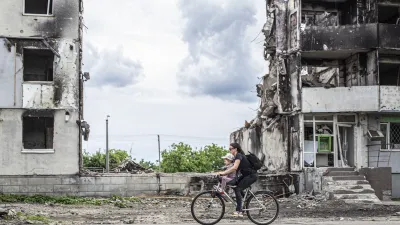In a speech Thursday, Mayor Bloomberg laid out his strategy for rebuilding a stronger, smarter New York in anticipation of future natural disasters.
In a speech that was short on specifics but frank in acknowledging the future challenges from the effects of global warming, Bloomberg laid out a multipronged approach to recovering from Superstorm Sandy while preparing for the next disaster. He touched on plans to expand the city's evacuation zones, "revise building codes and look for ways to better protect critical infrastructure like transportation and electrical networks," reports Michael M. Grynbaum.
While dismissing the case for "expensive experiments like sea gates," the mayor "said the city would consider the construction of dunes, jetties, levees and berms along coastal areas to help reduce damage from future storm surges. Height restrictions on some residential homes will be relaxed so owners can elevate their houses above the flood plain, and the city will update its building code to require more stringent protection against floods."
"The city will also update its flood maps and extend the so-called Zone A evacuation area to include Howard Beach, Queens, and the Brooklyn neighborhoods of Gerritsen Beach and East Williamsburg, communities that were heavily and unexpectedly damaged by flooding from Hurricane Sandy," notes Grynbaum.
“Let me be clear,” Mr. Bloomberg said. “We are not going to abandon the waterfront. We are not going to leave the Rockaways or Coney Island or Staten Island’s South Shore.”
“But we cannot just rebuild what was there and hope for the best,” he added. “We have to build smarter and stronger and more sustainable.” The city has convened a working group “to determine exactly what that means,” he said.
FULL STORY: Mayor Announces Plans to Protect City From Natural Disasters

Planetizen Federal Action Tracker
A weekly monitor of how Trump’s orders and actions are impacting planners and planning in America.

Restaurant Patios Were a Pandemic Win — Why Were They so Hard to Keep?
Social distancing requirements and changes in travel patterns prompted cities to pilot new uses for street and sidewalk space. Then it got complicated.

Map: Where Senate Republicans Want to Sell Your Public Lands
For public land advocates, the Senate Republicans’ proposal to sell millions of acres of public land in the West is “the biggest fight of their careers.”

Maui's Vacation Rental Debate Turns Ugly
Verbal attacks, misinformation campaigns and fistfights plague a high-stakes debate to convert thousands of vacation rentals into long-term housing.

San Francisco Suspends Traffic Calming Amidst Record Deaths
Citing “a challenging fiscal landscape,” the city will cease the program on the heels of 42 traffic deaths, including 24 pedestrians.

California Homeless Arrests, Citations Spike After Ruling
An investigation reveals that anti-homeless actions increased up to 500% after Grants Pass v. Johnson — even in cities claiming no policy change.
Urban Design for Planners 1: Software Tools
This six-course series explores essential urban design concepts using open source software and equips planners with the tools they need to participate fully in the urban design process.
Planning for Universal Design
Learn the tools for implementing Universal Design in planning regulations.
Heyer Gruel & Associates PA
JM Goldson LLC
Custer County Colorado
City of Camden Redevelopment Agency
City of Astoria
Transportation Research & Education Center (TREC) at Portland State University
Camden Redevelopment Agency
City of Claremont
Municipality of Princeton (NJ)



























